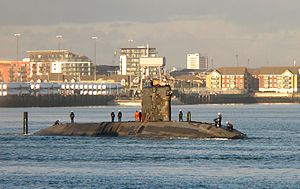 HMS Trafalgar, 2008 HMS Trafalgar, 2008
| |
| History | |
|---|---|
| Name | HMS Trafalgar |
| Namesake | Battle of Trafalgar |
| Ordered | 7 April 1977 |
| Builder | Vickers Shipbuilding and Engineering, Barrow-in-Furness |
| Laid down | 15 April 1979 |
| Launched | 1 July 1981 |
| Commissioned | 27 May 1983 |
| Decommissioned | 4 December 2009 |
| Homeport | HMNB Devonport, Plymouth |
| Fate | Awaiting Disposal |
| Badge |  |
| General characteristics | |
| Class and type | Trafalgar-class submarine |
| Displacement |
|
| Length | 85.4 m (280 ft) |
| Beam | 9.8 m (32 ft) |
| Draught | 9.5 m (31 ft) |
| Propulsion |
|
| Speed | Over 30 knots (56 km/h), submerged |
| Range | Unlimited |
| Complement | 130 |
| Electronic warfare & decoys |
|
| Armament | |
| Service record | |
| Operations: | Operation Veritas (Afghanistan) |
HMS Trafalgar is a decommissioned Trafalgar-class submarine of the Royal Navy. Unlike the rest of the Trafalgar-class boats that followed, she was not launched with a pump-jet propulsion system, but with a conventional 7-bladed propeller. Trafalgar was the fifth vessel of the Royal Navy to bear the name, after the 1805 Battle of Trafalgar.
Operational history
In 2012 a Royal Navy submariner was jailed for 8 years for trying "to pass secrets to the Russians that could have undermined Britain's national security"; one element of this was information on "a secret operation undertaken by HMS Trafalgar.
Combat history
After Operation Veritas, the attack on Al-Qaeda and Taliban forces following the September 11 attacks in the United States, Trafalgar entered Plymouth Sound flying the Jolly Roger on 1 March 2002. She was welcomed back by Admiral Sir Alan West, Commander-in-Chief of the fleet and it emerged she was the first Royal Navy submarine to launch Tomahawk cruise missiles against Afghanistan.
Grounding incidents
In July 1996, Trafalgar grounded near the Isle of Skye in Scotland.
In November 2002, Trafalgar again ran aground close to the Isle of Skye, causing £5 million worth of damage to her hull and injuring three sailors. She was travelling 50 metres below the surface at more than 14 knots when Lieutenant-Commander Tim Green, a student in the "Perisher" course for new submarine commanders, ordered a course change that took her onto the rocks at Fladda-chuain, a small but well-charted islet. Commander Robert Fancy, responsible for navigation, and Commander Ian McGhie, an instructor, both pleaded guilty at court-martial to contributing to the accident. On 9 March 2004 the court reprimanded both for negligence. Green was not prosecuted, but received an administrative censure.
In May 2008 it was reported that the crash was caused by the chart being used in the exercise being covered with tracing paper, to prevent students marking it.
Decommissioning
Trafalgar was decommissioned on 4 December 2009 at Devonport.
References
- Jane's Fighting Ships, 2004-2005. Jane's Information Group Limited. p. 796. ISBN 0-7106-2623-1.
- ^ Bush, Steve (2014). British Warships and Auxiliaries. Maritime Books. p. 12. ISBN 978-1904459552.
- ^ Graham, Ian, Attack Submarine, Gloucester Publishing, Oct 1989, page 12. ISBN 978-0-531-17156-1
- Hopkins, Nick (12 December 2012). "Royal Navy submariner jailed for trying to pass secrets to Russia". The Guardian. Retrieved 9 September 2022.
- Cheston, Paul; Razaq, Rashid (13 November 2012). "Royal Navy petty officer admits trying to give nuclear submarine secrets to Russia". Evening Standard. Retrieved 9 September 2022.
- Trafalgar Returns
- House of Commons Hansard Written Answers (publications.parliament.uk)
- "Latest Scotland, UK & World News - The Daily Record". dailyrecord.co.uk. Retrieved 7 August 2016.
- Dawar, Anil (23 May 2008). "Submarine's £5m repair bill blamed on tracing paper". The Guardian. Retrieved 7 August 2016.
- "Submarine's final sailing to base". BBC News. 10 November 2009. Retrieved 9 September 2022.
External links
- Royal Navy HMS Trafalgar (royalnavy.mod.uk)
- MaritimeQuest HMS Trafalgar pages (maritimequest.com)
- The BBC - Pictures of Trafalgar's final voyage (news.bbc.co.uk)
| Trafalgar-class submarines | |
|---|---|
| |
| Shipwrecks and maritime incidents in 2002 | |
|---|---|
| Shipwrecks |
|
| Other incidents |
|
| 2001 | |